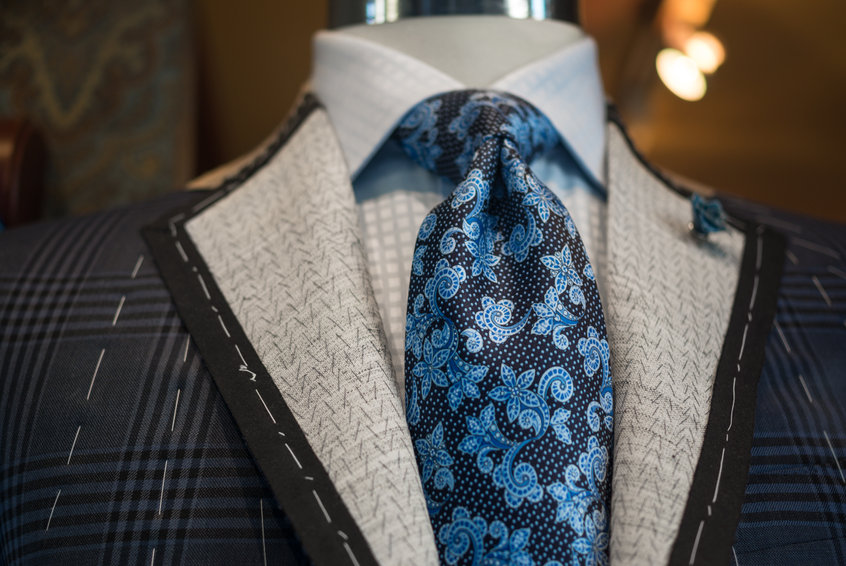Winter 2021 Suit Trends

When the icy chill of winter rears its frosty head, it’s time to push your linen and seersucker suits to the back of the closet and opt for something a bit warmer. Suit fabrics make all the difference when you’re forced to bear the cold while managing to look sharp.
However, winter suiting does not have to be boring. In the same way that the warm summer weather gave you a surfeit of outfit flexibility in the form of summer suits, you can apply the same creativity and style to your cold-weather ensembles.
Look cool and stay warm all winter long. Here is our definitive guide on what to look for in a winter suit.
Winter Suit Fabrics

The optimal winter suit will be made of a warmer, thicker fabric that will keep you nice and toasty against the elements. Stay away from the lighter suit fabrics like cotton, polyester, linen, seersucker, chambray, and fresco, as these will induce endless shivering. Unlike summer suits, winter fabric better lends itself to retaining a suit’s shape and maintaining its structure exceptionally well, so you won’t have to worry as much about wrinkling or wearing of material.
Put On Those Layers
There is nothing more important for winter fashion than knowing how to properly layer your outfit to help you look on point.
If you have a well-tailored suit, the next step is to ensure you’re adding sweaters, coats, and accessories that match and follow the latest trends.
Fortunately, simple plain sweaters and black or grey coats are no longer the only options available to men this season. Instead, the wardrobe has expanded to be playful while still standing out and making a statement.
Although winter can be cold, just ensure that your layers are breathable. This is for all those moments you have to step on public transportation or quickly pop into a coffee shop and suddenly have to deal with a lot of heat.
For that reason, any items that have the ability to unzip or unbutton to let some heat escape will be ideal for most situations and will still help you stay stylish.
The Wool Suit
To this day, wool remains the most popular suit fabric. Wool is a fabric renowned for its ability to drape nicely, maintain its form, and its versatility in being able to be spun as loose and breathable or tight and warm as necessary. Wool suits have maintained the position of being the most popular suit on the market for decades, because of these versatile qualities.
This is a great place to start acquiring your winter suiting, as a good wool suit is easy to find and comes in a variety of types. Worsted wool is the most popular wool used for suits, as it is highly adaptable to temperature change, wears well, and gives off that slight shine that you find in most suits on the market. Other popular types of wool are tweed and flannel. Worsted is considered mid-weight wool, tweed is heavier, and flannel is the heaviest. Flannel and tweed are discussed in greater detail below.
The Herringbone Suit
Much like tweed, the herringbone is heavy, warm, and durable. What distinguishes herringbone from tweed is a distinctive thin zig-zag pattern.
Like tweed, herringbone suits are made from twilled yarn, typically from materials like wool or flannel. Both tweed and herringbone fabrics consist of a tighter weave than most suits, making for a more structured and durable garment. The thickness of the fabric paired with the subtle zig-zag design cause this suit to give off an illusion of depth, making this suit ideal for gentlemen on the slimmer side.
The Tweed Suit
Tweed is a great winter suit fabric that will always give timeless ease to the wearer. The fabric is made from wool and created by combining three differently colored yarns, which are then twilled.
To “twill” is to weave yarn in such a way that it produces a distinctive pattern unique only to this variety of fabric. Tweed makes a fine winter suit choice because it is thick, warm, water-resistant, and durable. However, tweed suits are a little heavier compared with most suits, and the fabric is coarse to the touch. If you live in a very cold winter climate and you don’t mind the feel of the fabric, a tweed suit is definitely the way to go to make a classic statement.
Coats
Thankfully, colder weather does not mean that you need to sacrifice your chic style. An appropriate formal winter coat can make all the difference on a white winter commute.
Trench Coat
The trench coat is a knee-length double-breasted cotton jacket with a fabric belt and buckle. The origins of the trench coat can be traced back to Thomas Burberry, who helped popularize said article of clothing when he switched from wool to cotton, to allow the coat to be worn in more versatile weather conditions. The trench coat was subsequently widely adopted by British Forces during the first world war, hence lending the name.
Peacoat
While less formal than the above two, a peacoat provides sufficient insulation and stylistic gravitas to be worn as a winter coat. Peacoats are shorter than trench coats and topcoats and are always double-breasted in design. Peacoats often feature a taller and wider collar that can be flipped up and buttoned for extra warmth.
